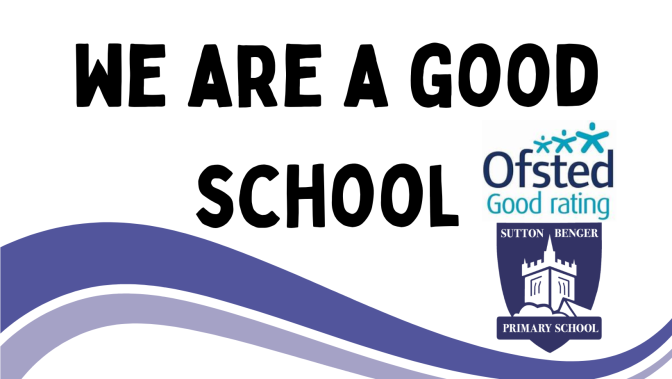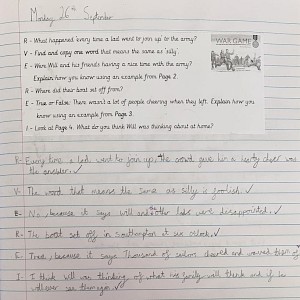Reading Curriculum Approach
INTENT:
At Sutton Benger School, reading is promoted as an intrinsic part of teaching and learning. We recognise and value reading as a pivotal part of our curriculum and so reading is embedded inour units of learning which allows our children to learn, grow and flourish within the reading curriculum and the curriculum as a whole.
We believe that learning to read and reading for pleasure transforms children’s lives. Our reading curriculum is deliberately vocabulary-rich as we believe this is vital to enable our children to become inspired and skilled readers.
We provide children with a literacy-rich environment, high quality texts and inspiring learning opportunities, with the intention of helping them to:
- gain a life-long enjoyment of reading and books;
- apply a knowledge of phonics in order to decode unfamiliar words with increasing accuracy and speed;
- read accurately, fluently and with understanding;
- be able to read with expression, clarity and confidence;
- develop a good linguistic knowledge of vocabulary and grammar;
- read and respond to a wide range of different types of texts;
- develop a deeper level of emotional intelligence and empathy;
- read fluently, and with confidence, in any subject in their forthcoming secondary education.
IMPLEMENTATION:
Reading is one of the most important things our children will learn and we recognise its importance from Early Years all the way to Year 6 and beyond. We cultivate reading behaviours throughout our curriculum and our children recognise the importance of reading for themselves as well as value its impact on their education.
Early reading in EYFS and KS1
The systematic teaching of phonics has a high priority throughout EYFS and Key Stage 1. We begin our children’s reading journey by the delivery of a high quality SSP - ‘Unlocking Letters and Sounds’. Our children learn to build on their growing knowledge of the phonetic code, mastering all phonemes and their corresponding graphemes, blending these to read, learning common exception words and ensuring fluency when reading sounds, words and books. Group reading accompanies our phonics provision - books are selected to match our children’s phonological ability and the sessions include decoding, comprehension and prosody. If children are not reaching these expectations we intervene quickly by giving daily 1:1 support. The content of these sessions is determined by on-going ‘barrier and gap’ analysis and our in depth knowledge of each child. These sessions are additional to our daily phonics sessions. In Key Stage 2 some children may continue to access phonics learning through this 1:1 intervention support.
Learning to Read; Reading to Learn
Our curriculum is blocked as units of learning within a 39-week curriculum map. The children are fully immersed in a curriculum unit and reading is woven throughout them. We recognise the wealth of good quality, rich texts that can supplement the foundation subjects and we offer our children a range to access as well as extracts to support them. Our curriculum is vocabulary-rich and this is developed through our reading curriculum. Children are given opportunities to develop and practice their vocabulary and oracy so that they become confident, articulate readers. In addition,we build progressive understanding of the key concepts of reading.Children are explicitly taught the skills of reading from Year 2 through the use of VIPERS sessions which link to units where appropriate. We teach the following key reading domains – vocabulary, inference, prediction, explanation, retrieval, sequencing (Y2)/Summarising (Y3-6). Children are given the opportunity to develop their reading fluency and comprehension skills and all children are given an equal opportunity to succeed against age related expectations. Support is provided through targeted conversations and modelling during these sessions in order to challenge all learners.
Reading Culture – Reading for Pleasure
A culture of reading for pleasure is embedded across the school. To support this, key texts are developed for each year group to represent a wide, rich, diverse and inclusive variety of age appropriate reading. We ensure that we:
- have a daily ‘3 o’clock’ read to enjoy a class text together;
- use teacher knowledge of children’s literature to show enthusiasm and knowledge and develop children’s access to high quality texts;
- use teacher knowledge of their children’s reading practices to help nurture reading for pleasure and build a reading community in classes;
- create environments which encourage reading for pleasure and informal book talk;
- encourage book talk through children reading independently and with others.
Reading Books for Independent Reading
From EYFS to Year 1 our children have phonetically decodable books to help them practise and develop their phonetic skills. Books are levelled to match their ability, which is determined through regular assessments. These books are accompanied with a library book to read for pleasure with parents / carers at home. Access to decodable books continue where needed in Year 2 and onwards where phonics is still being taught as a route to reading. After this, the children then move to ‘free readers’ where they are encouraged to select their books for engagement and enjoyment. When reading with an adult in school, there is a focus on book talk as well as building on decoding (where necessary), fluency and prosody. In all classes across the school, we identify ‘priority readers’. These children are given more frequent opportunities to read with an adult across the week.
Reading at home
We know that reading at home is one of the most important ways in which children can be supported. At school, they are taught the skills they need to decode words as well as read with comprehension and prosody. To consolidate these skills and become more confident and competent readers, they need lots of practice and encouragement and this in turn develops a pleasure for reading. We are aware of the importance for our children to read at home with their families to develop these skills and develop that love of reading that can last a lifetime. We support our parents with their child’s reading journey by promoting daily reading at home and supporting them in helping their child.
IMPACT:
Children at Sutton Benger CE Primary School enjoy ‘Being Readers’ and flourish within our curriculum. Through the teaching of systematic synthetic phonics, our children become fluent readers by the end of Key Stage 1. With decoding taught as the prime approach to reading, pupils will become familiar with this strategy and have the confidence to work out unfamiliar words in any new texts they encounter in the future. Pupils also have the opportunity to develop their fluency and comprehension as they move through the school; accessing a range of texts independently. Attainment in reading is measured using statutory assessments and regular teacher assessments.
We believe that reading is the key to unlocking all learning and so the impact of our reading goes beyond reading assessments. We give all the children the opportunity to enter the amazing new worlds that books open up to them and share texts from a range of cultures or genres to inspire them to question or seek out more for themselves. Reading is the golden thread that runs through a child’s journey at our school. When they leave us, we want pupils to possess the reading skills and love of literature which will help them to enjoy and access any aspects of learning and enjoyment they encounter in the future.

